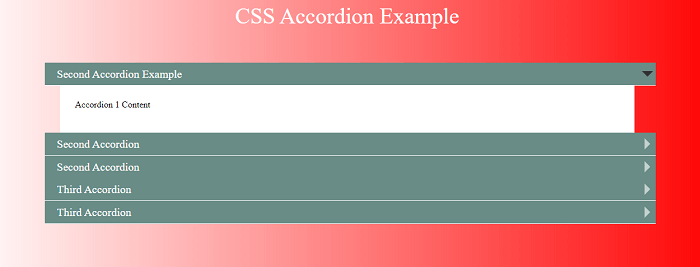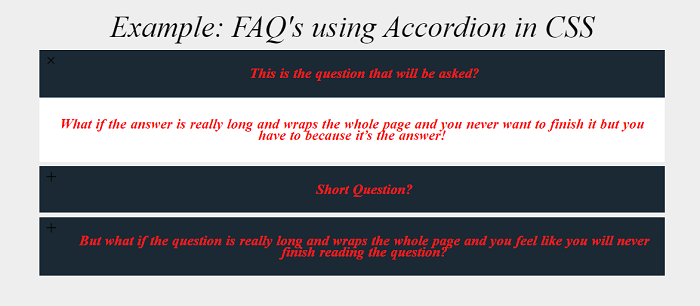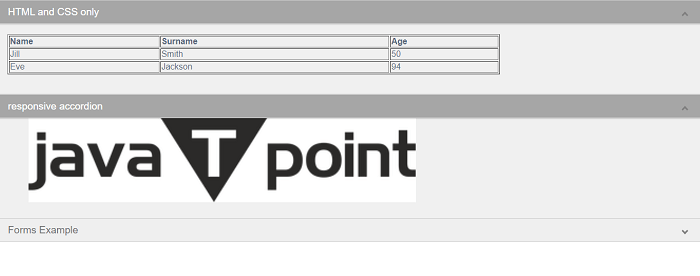Accordion in CSSAccordion pattern in CSS is a user interface that is made up of vertically stacked collapsible and expandable items such as panels or sections. In this, only one item gets to open at a time because each of them usually has a heading part and the actual content. On the other hand, clicking on an item's header makes it reveal its content while the rest get hidden. Usually composed of several items stacked vertically, with a header and a content section for each item. By showing only one panel at a time and offering an easy-to-use mechanism for users to expand and collapse individual sections as needed, the main objective is to conserve screen space. To create an accordion in CSS, you can use HTML, CSS, and sometimes some JavaScript or jQuery for interactivity. What do you mean by Accordion in CSS?The Accordion menu in CSS is a graphical element consisting of a vertically stacked list of items. This menu can be clicked to reveal or hide content associated with them. Every website contains a CSS accordion in at least one of their pages if they have a FAQ section. Let's take various examples of accordion in CSS. ExamplesExample 1: Here is a simple example: Every accordion item in this example has a header and a content section. These elements are styled, and their visibility is controlled using CSS. Toggling the visibility of the related content sections by clicking on the headers would fall under the purview of JavaScript or jQuery. Remember that the example above is a basic implementation; there are many variations and libraries available for creating accordions. Example 2:Explanation: In the above example, we have created an accordion with the help of CSS. When we click on the particular section, the description of the section is open. Output: Following is the output of this example. 
Example 3:Explanation: In the above example, we have created an accordion with the help of CSS. When we click on the particular section, the description of the section is open. Output: Following is the output of this example: 
Example 4:Explanation: In the above example, we have created an accordion with the help of CSS. When we click on the particular section, the description of the section is open. Output: Following is the output of this example: 
PropertiesDepending on the exact design and organization you're going for, there are a variety of properties you can use in CSS to create an accordion-style interface. Here are a few typical characteristics, though, along with an explanation: 1. Display Property:
2. Border Property:
3. Margin and Padding Properties:
4. Cursor Property:
5. Background Property:
6. Transition Property:
7. Position Property:
8. Overflow Property:
9. Visibility Property:
10. Height and Max-Height Properties:
These properties are only a starting point; the actual properties used will be determined by the accordion's unique design and layout specifications. Additionally, dynamic behavior and interactivity may be handled by scripting languages such as JavaScript. ConclusionIn conclusion, an accordion is a flexible user interface pattern in CSS that creates content into panels that can collapse, saving screen real estate and improving user navigation. Designers use attributes like display, transition, and height to produce aesthetically pleasing interfaces with fluid animations. In many cases, JavaScript enhances CSS, allowing for interactive features like header-click expansions. This dynamic, space-efficient design makes information easily readable and arranged, which promotes user-friendly online experiences. |
 For Videos Join Our Youtube Channel: Join Now
For Videos Join Our Youtube Channel: Join Now
Feedback
- Send your Feedback to [email protected]
Help Others, Please Share










